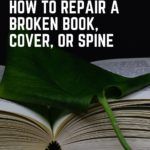First, you’re going to need the right supplies. If you’re a crafty person, you might already have some of these things at home, but if not, you buy any number of book repair or bookbinding kits, like this one or this one.
Book Repair 101: How to Repair a Broken Book
What You’ll Need for Book Repair
fine paint brush acid-free glue bone folder wax paper tape weights
You want a glue that dries clear and is flexible when dried. Elmer’s Glue works just fine, but PVA craft glue is a better bet if you want your book repair to last. You’ll actually probably want a few different tapes for different jobs. For torn pages, you’ll want something like this document repair tape. For loose bindings, you’ll want binding repair tape. If you want a budget option, plain masking tape is okay, too, but make sure it’s acid-free.
To Repair a Ripped Page or Jacket
Oh no. You’ve ripped a page in your book. Never fear! You already stocked your book repair kit! You’ll need your fine paint brush, glue, wax paper, and bone folder. This also works for a torn book jacket. 1: Place a piece of wax paper underneath the ripped page. 2: Using your fine brush and just a tiny amount of glue, paint the glue over the tear. 3: Place another piece of wax paper over the tear, and press the bone folder over the tear to make sure the glue gets good contact and to get rid of any bubbles. 4: This is optional, and will make the tear more noticeable, but you can put a tiny bit of tape over the edge of the page to reinforce it and make sure the tear isn’t re-opened. You’ll want to rip the tape gently, rather than cut it, so that the feathered edge of the tape blends into the page.
To Repair a Sagging Book Block/Loose Spine or Missing Pages
Does the inside of your book seem to want to throw off its clothing and run free? This is an easy fix. You’ll need binding repair tape. If the pages of your book are coming out in one whole chunk (that whole chunk is called a book block) or in individual pages, this is what you want to do. You’ll want binding tape and a bone folder.
To Repair a Broken Cover
Has your cover completely fallen apart, or do you fear it may soon? You’ll want to get out your book binding repair tape. This isn’t pretty, but it will keep your book in your collection for a while. Transparent binding tape means you’ll still be able to see the title or spine decoration.
To Reattach a Book Spine
This typically only happens with older books, but it happens to the older books on my shelves quite often. I have a baggy full of spines just waiting to be reattached to their books. You’ll need binding tape, a bone folder, glue and paint, and something soft to wrap the book in, like a T-shirt or a non-adhesive bandage or wrap.
How to Protect Your Books
Now, the very best thing you can do to repair your books is to prevent them from getting damaged in the first place, but if I had led with that, you’d have closed the tab and hated me forever, and I’d have deserved it. But I can’t let you leave without some tips for how to protect your books.
A Book Buddy
These cushioned slipcovers prevent your books from being dinged up when you throw them in your purse or tote bag.
Jacket Covers
Cover the jackets of your hardcovers (especially antiques) in acid-free, UV-blocking covers.
Acrylic Cookbook Stand
While using cookbooks, gardening books, or other reference books on potentially messy topics, put them in an acrylic cookbook stand like this one with a splash guard.
Stake Your Claim
If you want to try to ensure you see your books again, you should mark your books as yours in some way. You can use an Ex Libris sticker or an embossing tool, or, if you just hate to mark up your books, you might consider lightly writing your name in pencil. This can be erased when the book returns safely home to you. For more tips on protecting your books, check out these Book Riot articles: 8 Ways to Waterproof Your Summer Reads How to Clean Books How to Save a Wet Book How to Remove Stickers from Books How to Care for Old for Valuable Books How to Fix Book Binding Thanks to the YouTube channel from the Bodleian Social Sciences Library at Oxford University. Their book repair videos were invaluable in researching this post.
